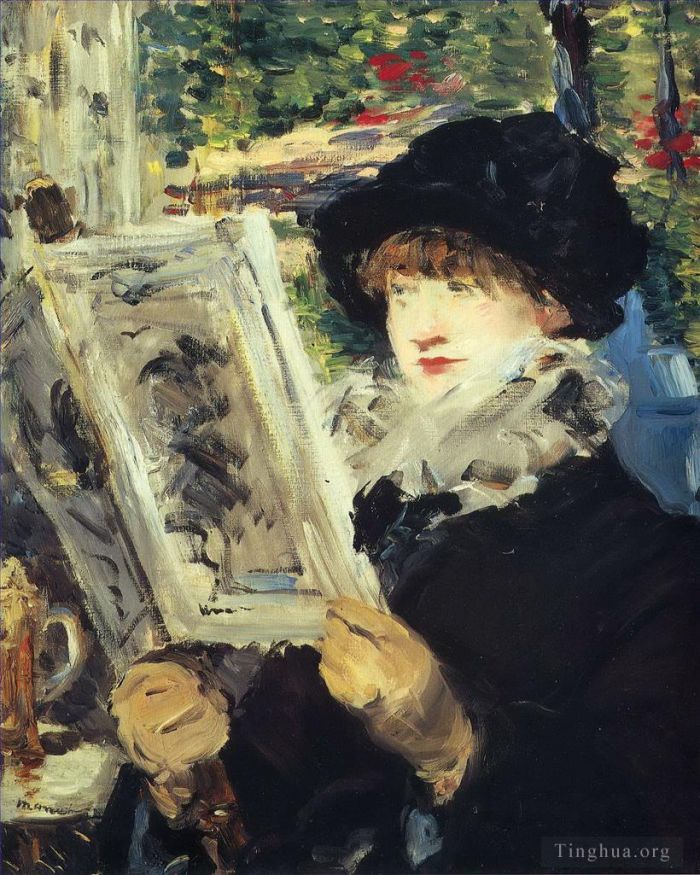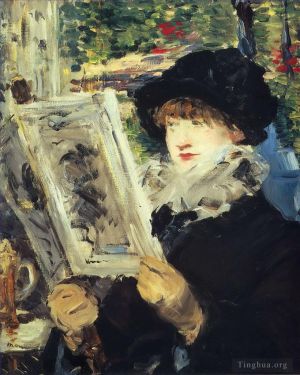Woman Reading
Edouard Manet
- Price: Price on Request
- Art Type: Oil Painting
- Size:
- English Comments: 0
- International Comments: 0
- Creating Date:
- Introduction and Works of Edouard Manet >>
Work Overview
- Woman Reading
Edouard Manet
Original Title: Le journal illustre
Date: c.1879; Paris, France *
Style: Impressionism
Genre: genre painting
Oil on canvas
24 1/16 x 19 7/8 in. (61.2 x 50.7 cm)
Location: Art Institute of Chicago, Chicago, IL, US
Around 1870 Edouard Manet adopted the blonde palette favored by the Impressionist circle, at the same time selectively transmuting his own brand of summary handling into a still more immediate, rapid-fire manner. Woman Reading is one of several paintings from this phase of his career, during which he portrayed Parisian drinking and theatrical venues. The sketchiest of the series, this canvas also appears to be the simplest. However, looks can be deceiving.
Manet here depicted a fashionably dressed young woman sitting in a café or brasserie—presumably outside, for she remains bundled up. She holds an illustrated journal, one of the periodicals provided for the establishment’s clientele. But it is not clear that she is reading; she might be using the large pages to screen surreptitious looks coming from her right. In any event, there seems to be a hint of avidity in her expression. The landscape behind her, rendered in quick dabs of green, blue, and red, might be an adjacent garden; then again it could be a decorative mural, as is suggested by the waterfall-like passage of blue over her left shoulder.
In Woman Reading, Manet seems to have reveled in the commercialized pleasures and studied self-presentations that animated Paris. Following his lead, we delight in the smeary yet elegant gloved hands; the lightly applied, "whipped" strokes of the collar; and the teasing evocation of the journal’s cover illustration, which hovers on the brink of legibility. Far from being incidental, such virtuosic, playfully ambiguous passages embody Manet’s response to the Impressionism practiced by his younger colleagues. Shaped by his urbane pictorial intelligence, this active surface, like the image as a whole, celebrates the elusive, equivocal character of modern representation.
- Copyright Statement:
All the reproduction of any forms about this work unauthorized by Singing Palette including images, texts and so on will be deemed to be violating the Copyright Laws.
To cite this webpage, please link back here.
- >> English Comments
- >> Chinese Comments
- >> French Comments
- >> German Comments
- >>Report
- Basket of Fruits
- The monk at prayer
- At Father Lathuille
- The Luncheon on the Grass (The Bath)
- The Grand Canal Venice
- Portrait of Emile Zola
- Portrait of Lina Campineanu
- Young Man in the Costume of a Majo
- The Bullfight
- Bench in autumn
- Victorine Meurent in the costume of an Espada
- Portrait of Zacharie Astruc
- Carnations and clematis in a crystal vase
- A boy with a pitcher
- Madame Brunet
- A matador
- On the Beach at Boulogne
- Reading Mme Manet and Leon
- Peaches
- The Kearsarge at Boulogne (Fishing boat coming in before the wind)
- Interior at Arcachon
- The ragpicker
- Woman in furs
- The model
- Madame Manet on a Blue Sofa
- Monet in his Studio Boat (Claude Monet Painting on His Boat-Studio in Argenteuil)
- Guitar and Hat
- The House at Rueil
- The Suicide
- Branch of White Peonies and Pruning Shears
- Jetty at Boulogne
- Portrait of Faure as Hamlet
- The Railway (Gare Saint-Lazare)
- Marguerite de Conflans Wearing Hood
- Theodore Duret
- Steamboat Leaving Boulogne
- Portrait of Gilbert Marcellin Desboutin
- Still Life Fruits on a Table
- The garden around Manet house
- Corner of a Café-Concert
- Boy with Dog
- Portrait of Mademoiselle Claus
- Young woman with a pink shoe
- Le Bon Bock A Good Glass of Beer
- Boy Blowing Bubbles
- Berthe Morisot with a Bouquet of Violets
- Portrait of Monsieur Brun
- Portrait of Emilie Ambre in the role of Carmen
- Effect of Snow at Petit Montrouge
- Vase of White Lilacs and Roses
- View of the 1867 Exposition Universelle
- Study of trees
- Moss Roses in a Vase
- Angelina
- Roses in a Champagne Glass
- Spring Study of Jeanne Demarsy
- The barque of Dante Copy after Delacroix
- The Street Singer
- Singer at a Cafe Concert
- Baudelaires Mistress Reclining Study of Jeanne Duval
- The Lemon
- Repose Study of
- A Game of Croquet
- Polichinelle
- Masked Ball at the Opera
- Bundle of Asparagus
- The Departure Of The Folkestone Boat
- The spanish ballet
- Argenteuil
- Plum
- At the Cafe
- Bench
- Gypsy with a Cigarette
- Rose and tulip
- Vase of Peonies on a Small Pedestal
- The Dead Christ with Angels
- Stephane Mallarme
- Nana
- Music in the Tuileries
- Christ with Angels
- Madame Manet in conservatory
- Swallows
- The Luncheon in the Studio
- Flowers in a Crystal Vase
- Madame Manet at the Piano
- Rochefort Escape
- The philosopher
- Still Life with Brioche
- Lola de Valence
- Bull fighting scene
- Portrait of Eva Gonzales
- Bouquet of flowers
- Eva Gonzales
- The Spanish Singer The Guitar Player
- Portrait of Mademoiselle Isabelle Lemonnier
- The Blonde with Bare Breasts
- The Waitress
- Woman with umbrella
- Young woman in the garden
- A Corner of the Garden in Rueil
- Madame Manet at Bellevue
- The Rest portrait of
- Woman Reading
- Bathers on the Seine
- Two Roses on a Tablecloth
- Le Chemin De Fer The Railroad
- The burial
- Execution of the Emperor Maximilian
- Embarkation after Folkestone
- Portrait of Henry Bernstein as a Child
- Head of a Dog
- The head of Christ
- Mother in the Garden at Bellevue
- Autumn Study of Mery Laurent
- The Races in the Bois de Boulogne
- Still life with melon and peaches
- Woman Before a Mirror
- Jesus Mocked by the Soldiers
- Flowers In A Crystal Vase flower Impressionism Edouard Manet
- The Port of Bordeaux
- A brioche
- Rue Mosnier decorated with Flags
- The Banks of the Seine at Argenteuil
- Lilac in a glass
- Woman Pouring Water Study of Suzanne Leenhoff
- The Monet family in their garden at Argenteuil
- View of Holland
- Portrait of Antonin Proust Realism Impressionism Edouard Manet
- Boating
- A King Charles Spanie
- Peonies in a vase
- The Horsewoman
- M and Mme Auguste Manet
- The conservatory
- Woman in a Tub
- A young man peeling a pear
- The Jetty at Boulogne
- Interior of a Cafe
- The ham
- On The Beach
- Pertuiset Lion Hunter
- The grand canal of Venice
- Oysters
- The Execution of the Emperor Maximilian of Mexico
- In the garden
- Portrait of Antonin Proust
- Victorine Meurent
- Young woman with a book
- Tarring the Boat
- Young woman in a round hat
- The Races at Longchamp
- The Milliner
- At the races
- The absinthe drinker
- Olympia
- Seascape at Berck Fishing Boats and Fishermen
- The old musician
- The Balcony
- Fishing
- Madame Auguste Manet
- The Boy with Cherries
- The Fifer
- Women at the Races
- Portrait of Suzanne Manet
- Surprised Nymph
- Portrait of Monsieur Tillet
- Almonds currants and peaches
- The stroll
- Young Woman in Oriental Garb
- Battle of Kearsage and Alabama
- The road menders Rue de Berne
- Woman with a Parrot
- Boy with a sword
- Eel and Red Mullet
- Woman with Fans (The Lady with Fans or Portrait of Nina de Callias)
- The Café-Concert (At the Café or The Bock Drinkers)
- The salmon
- Seascape at Arcachon
- The Garden at Bellevue
- The dead toreador
- Young Woman Reclining in Spanish Costume
- Young woman among the flowers
- Woman fastening her garter
- A Bar at the Folies-Bergère
- Bouquet Of Violets still life Impressionism Edouard Manet
- The Port of Bordeaux 2
- Head Of A Man
- Young woman in a negligee
- Portrait Of Mme Jules Guillemet
- On the Bench
- The Barricade Civil War









 Singing Palette
Singing Palette